There’s a reason snake plants are my favorite houseplant. First, they have attractive upright foliage in a range of colors and variegations. Secondly, they’re super easy to grow, tolerating most light conditions and thriving on neglect. That said, occasionally you may notice snake plant leaves turning yellow. Don’t panic! It’s not easy to kill a snake plant. You just need to figure out the issue. Below I share nine reasons a snake plant’s leaves may turn yellow and how to fix them.
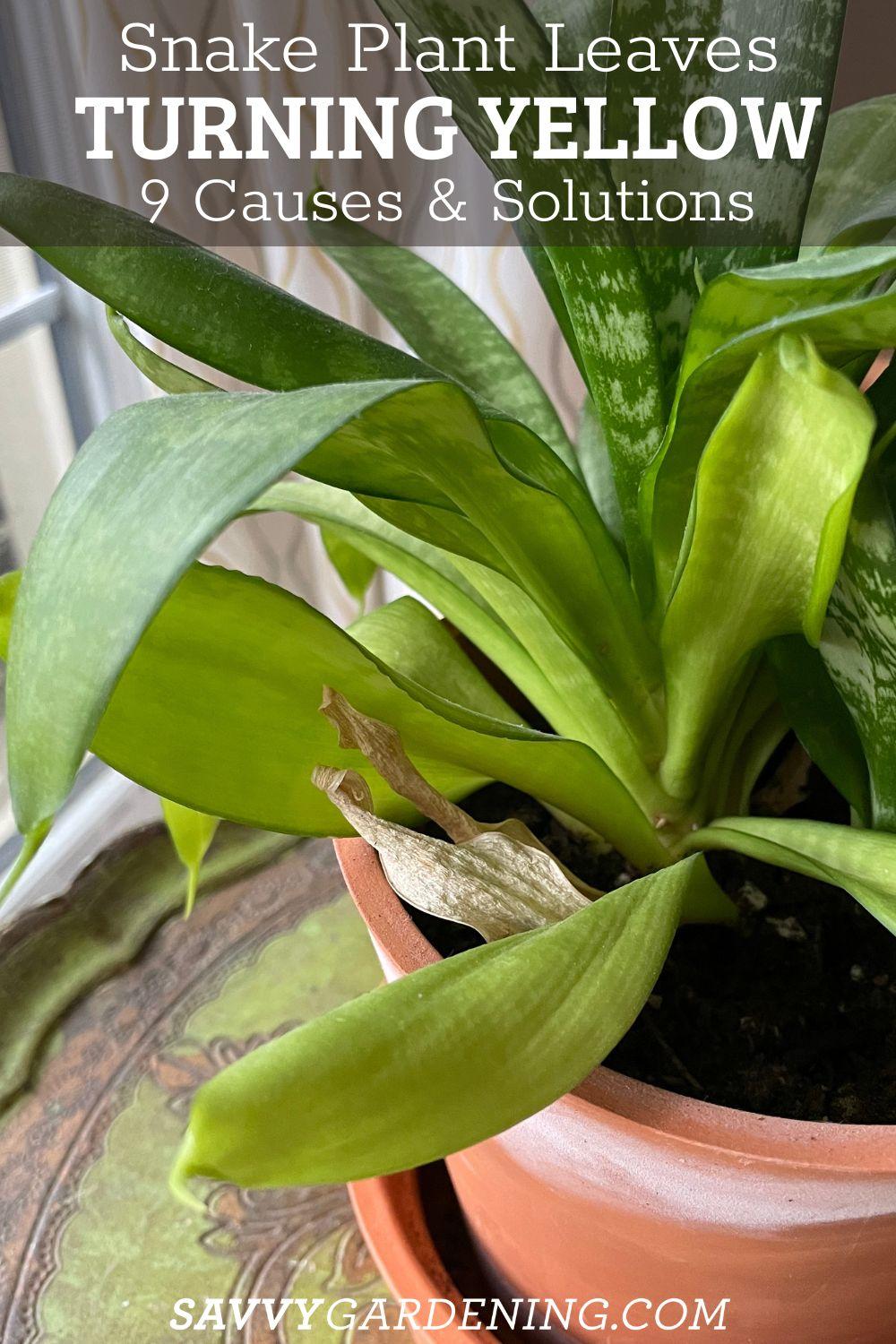
What are snake plants?
Tropical plants native to parts of Africa, snake plants are known botanically as Dracaena trifasciata. For years, they were classified as Sansevieria trifasciata, but that recently changed. When shopping for this popular houseplant, most gardeners ask for snake plant or call it by its other common name, mother-in-law’s tongue. These succulent plants have stiff upright foliage that is often variegated with horizontal stripes or bands of gold, light green, or gray. The leaf edges may also be edged in light green or gold, depending on the type.
There are many species and cultivars of snake plants with some growing compact and others reaching heights of 6 feet or more. Most snake plants have the characteristic flat pointed leaves, but some have unique tubular foliage. I have over a dozen snake plants in my collection and find them all carefree indoor plants.
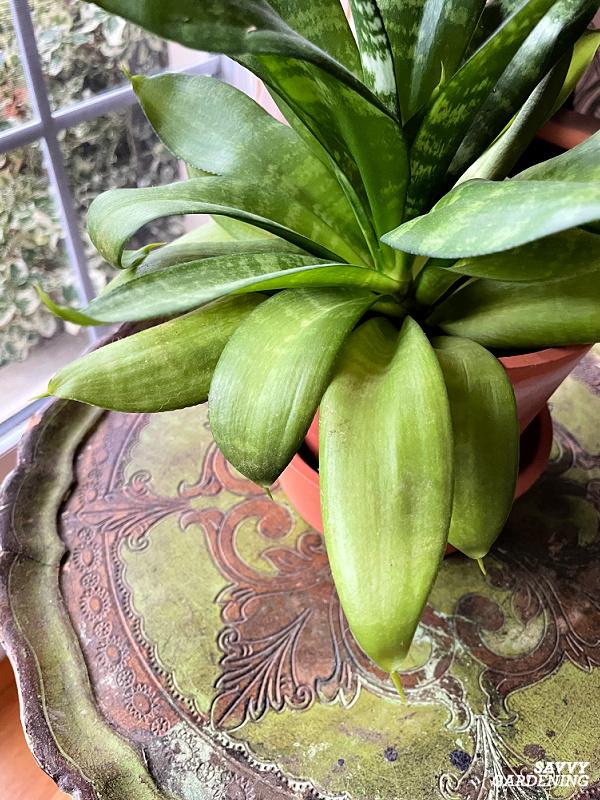
To learn more about why snake plant leaves turn yellow, watch this video:
9 Causes of snake plant leaves turning yellow
As noted above, snake plants have a well-earned reputation for ease of cultivation and resilience, but from time to time you may notice your snake plant leaves turning yellow. Below I explore 9 reasons for this and offer tips on how to fix the issue.
Cause 1: Overwatering (The biggest reason for snake plant leaves turning yellow)
If you find your snake plant leaves turning yellow, the first question to ask is ‘How often am I watering?’. Snake plants are very drought tolerant and overwatering results in root rot, yellowing leaves, and can eventually kill the plant. This isn’t a plant that needs a watering schedule. I keep my snake plants on the drier side only watering when the top inch of potting soil has dried out. Stick your finger into the growing medium to gauge moisture levels.
Poor drainage can contribute to overwatering. Be sure to grow snake plants in containers that have drainage holes. This allows excess water to drain from the growing medium and collect in a saucer or tray. As for growing medium, I use a succulent potting mix for snake plants. It’s a very well-draining soil mix and made up of ingredients like coir, peat moss, perlite, or coarse sand.
Cause 2: Underwatering
Read more : Why Is My Chickens Comb Pale
I just talked about how too much water can be the cause of snake plant leaves turning yellow, but so can too little water. These are drought tolerant plants, but they do need soil moisture. If they’re underwatered the leaves shrivel, turn yellow, and fall off. Again, it’s best to maintain a very lightly moist soil with the top inch of the growing media dry before the next watering.
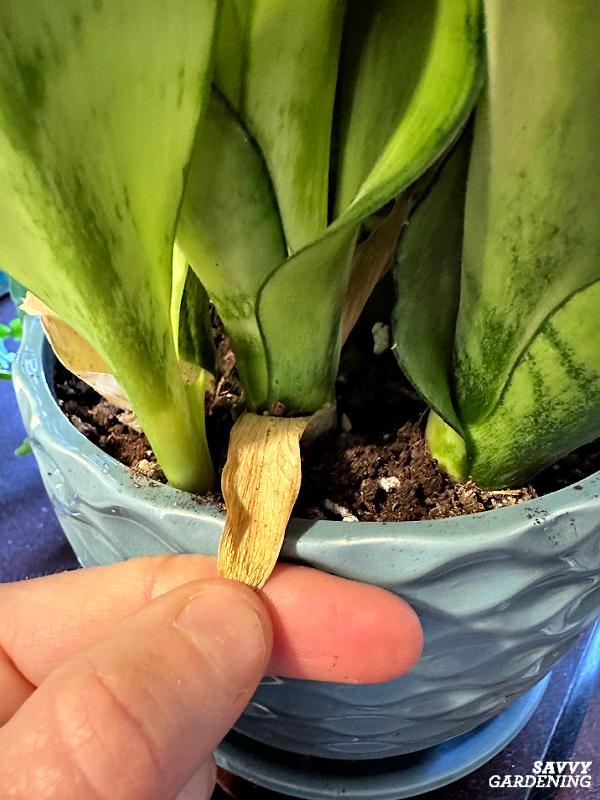
Cause 3: Too much light
Another reason for yellow leaves is too much light. A full day of direct sunlight can bleach the leaves from green to yellow to white. Snake plants grow best in a site with bright, indirect sunlight. To prevent leaf scorch, or burn, avoid intense mid-day light or a window that receives more than five hours of sun each day. You’ll know that too much direct sunlight is to blame for yellowing leaves if the affected foliage is on the window side of the plant. Another symptom of excessive light is dry, wrinkled leaves.
To fix this issue, place the snake plant to a window with only indirect light or one that offers just a few hours of early or late day sun. If you move your houseplants outdoors for the summer, give them a site that is shaded from direct sunshine.
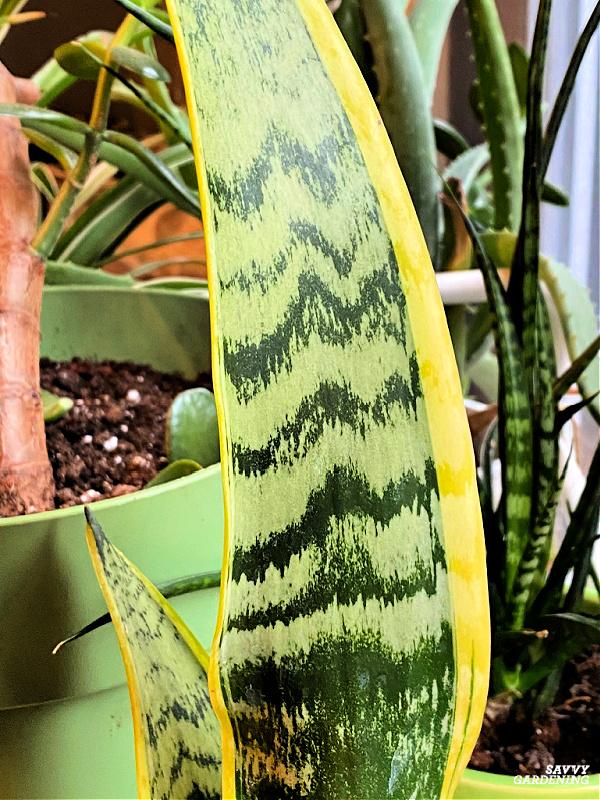
Cause 4: Too little light
Snake plant is often the houseplant that is tucked into a dark corner of a home. And while they can grow in most conditions, too little light affects plant health. Plants need light to photosynthesize and when they don’t receive adequate light their growth slows, as does the production of new leaves. You’ll also notice that leaf appearance can change in low light. Variegated leaves may turn green or the variegations may become more muted. The foliage also turns pale, often yellow in color. So if you notice your snake plant leaves turning yellow and it’s sitting in a spot with little to no light, it’s time to move it to a brighter site. If that’s not possible you can add a grow light above the foliage.
It’s important, however, to increase light levels gradually. Don’t take a low light snake plant and place it in a bright window. I recommend introducing the plant to increased light levels over several weeks. This allows it to acclimatize to higher levels of light without scorching or burning the leaves.
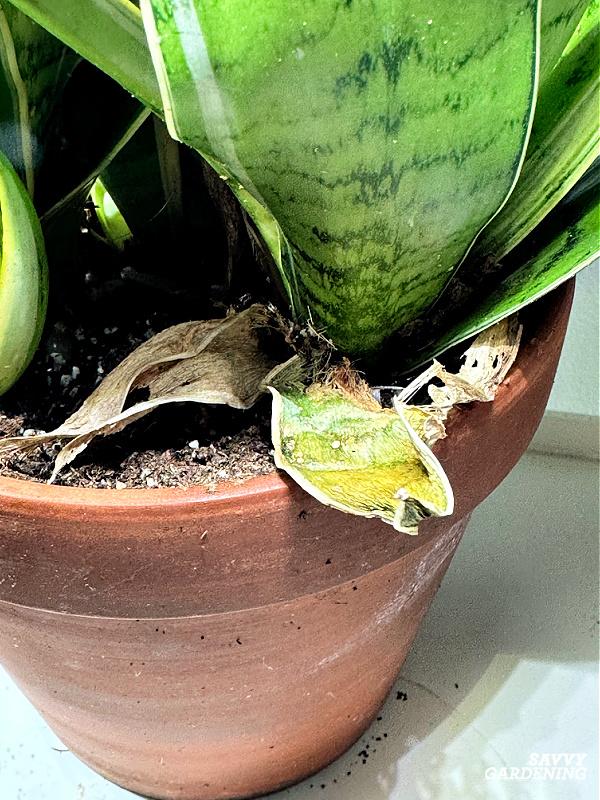
Cause 5: Variegated leaves
One of the reasons I love snake plants so much is that the leaves of most varieties have eye-catching variegations and markings. These range in color from light to deep green, as well as cream to gold. If you’re not familiar with variegated snake plants you may wonder if the yellowing on the leaves is a symptom of a problem like too little light or overwatering. In this case it’s best to check with a gardening friend or share a photo in your favorite online gardening forum.
It’s best to be sure and because there are many types and cultivars of snake plants, you’ll find a wide range of colors and combinations. And as noted above, the coloration of snake plant leaves can also shift once it settles into your home.
Cause 6: New foliage
As snake plants grow, the new foliage that emerges can look quite different from the existing mature leaves. Often the young leaves are pale yellow or light green in color. That’s normal growth and not a reason to worry. As the leaves mature they’ll develop the true leaf color and variegations.
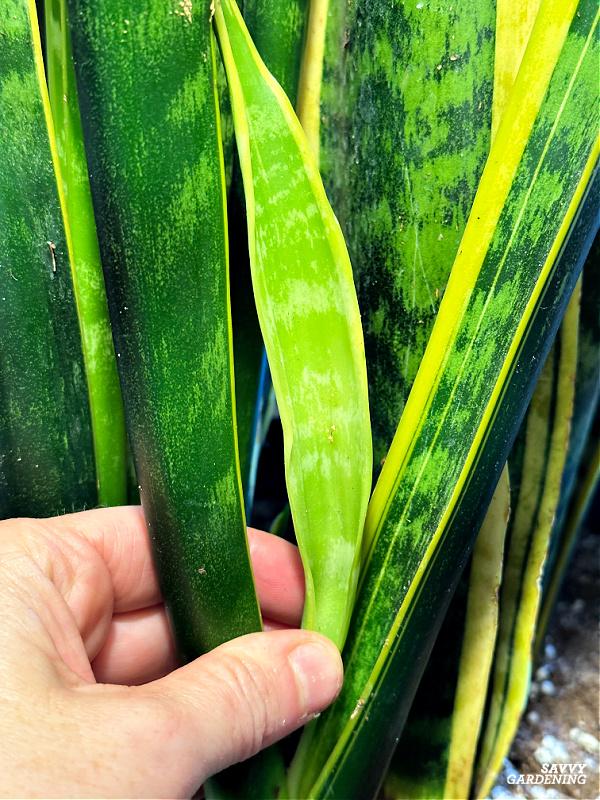
Cause 7: Old foliage
Houseplants are living, growing organisms and their leaves don’t last forever. This is a normal part of their lifecycle with the oldest leaves turning yellow to brown and then falling off. If the leaves showing discoloration are the oldest ones, there is no problem to fix. You may, however, wish to remove these leaves. Below I offer tips on when and how to prune back yellowing snake plant leaves.
Cause 8: Not fertilizing
Read more : Why Are People So Sensitive Nowadays
Unlike garden plants, houseplants depend on us for a steady supply of essential nutrients like nitrogen, phosphorous, potassium, and magnesium. Nutrient deficiency can show up as pale or yellowing leaves. Snake plants don’t have high fertility needs, but they do need to be fed occasionally. The best time to fertilize a snake plant is when it is actively growing from early spring through mid-summer. Don’t fertilize in autumn and winter when the plant is semi-dormant.
I fertilize snake plants every two months during the growing season using an organic all-purpose liquid fertilizer. Mix it in a watering can and apply it to the growing medium. Be sure to read the label and dilute the fertilizer product properly to avoid over feeding the plant.
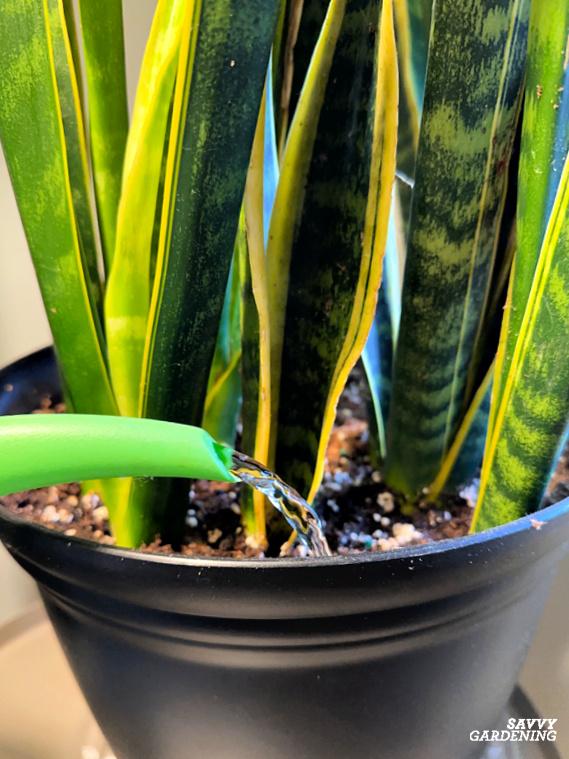
Cause 9: A pest infestation
In my experience, snake plants are rarely bothered by pests, but occasionally you may spot aphids, spider mites, or other insects on the leaves or in the growing medium. They can come into your home when you buy new plants or bring houseplants back indoors at the end of summer. Other common houseplant pests include mealybugs and thrips. A serious pest infestation can be one of the reasons for discolored leaves.
Signs of pest problems include yellowing leaves, webbing, small pinprick spots on foliage, and honeydew, a sticky substance produced by insects like aphids. When I find pests on a houseplant, I immediately move it to a room with no other plants to prevent spread. Next, identify the pest. This helps you figure out how to address the issue.
For a pest like aphids I take the plant outdoors and use a jet of water from a spray bottle or my hose to knock the pests off the plant. To deal with mealybugs, I dampen a cotton ball with isopropyl rubbing alcohol and wipe the pest from the leaves. For spider mites, as well as aphids and other insects, an insecticidal soap is effective. You may need to spray every 4 to 5 days until the pest is no longer present.
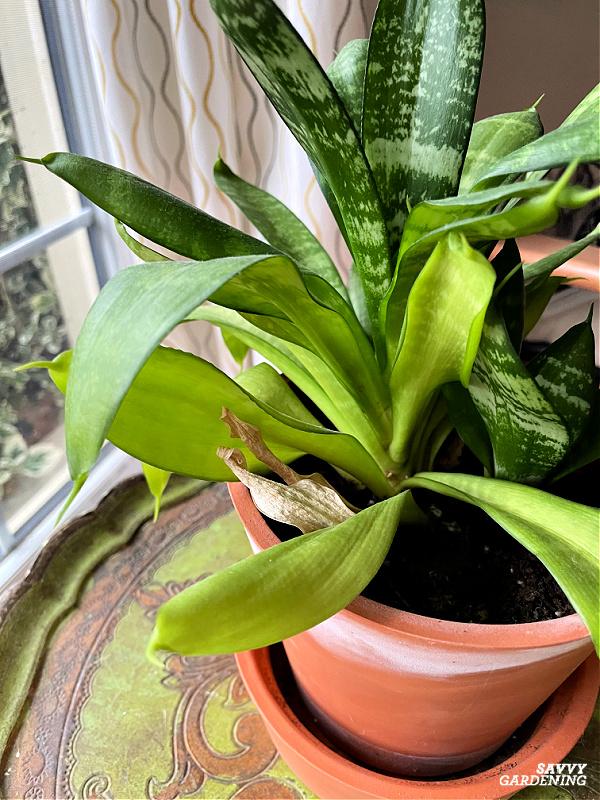
Should you remove yellow snake plant leaves?
Yellowing leaves on a snake plant may look alarming, but the damage is sometimes reversible. For example, if the pale color or loss of variegation was caused by low light, moving the plant to a site with more sun can green up the leaves. However if the leaves have progressed to bright yellow or turned brown, it’s best to remove them. Using sharp, clean garden snips or hand pruners, cut the leaf off at the bottom of the plant.
Other ways to prevent snake plant leaves turning yellow
I’ve got a few more tips on how to prevent snake plant leaves turning yellow.
- Repot every 3 to 4 years – Occasionally snake plants need to be repotted into a larger pot. If left to grow in the same sized container for many years, the plant becomes root bound and that can stress the plant, resulting in yellow leaves. To check if the roots have run out of space, slip the plant from its pot. If there is little visible soil and the roots are circling tightly, it’s time to move it to a larger container. Learn more about when and how to repot a snake plant.
- Avoid sites with temperature fluctuations – Protect your snake plants from temperature extremes. These plants do best in average from temperature. Placing a snake plant near a door that is frequently opened in cold weather can shock this tropical plant. A drafty window is also to be avoided as temperatures below 55 degrees Fahrenheit (13 degrees Celsius) can damage foliage and cause the leaves to yellow.
- Avoid heat sources – It’s also important to avoid placing a snake plant near a heat source like a heat pump, fireplace, or radiator. These can dry out the growing mix or the foliage.
For more information on growing snake plants and other succulents, be sure to check out these articles:
- When to repot a snake plant
- 12 low-light succulents to grow
- Hanging succulent plants: 16 awesome options
- How to grow string of dolphins
Is your snake plant turning yellow? I hope we provided you with information and solutions to fix the problem.
Source: https://t-tees.com
Category: WHY
